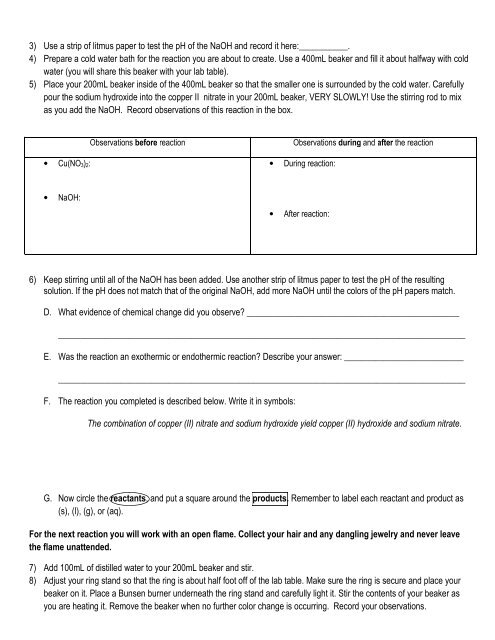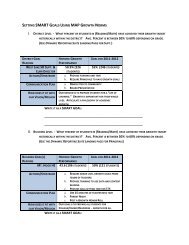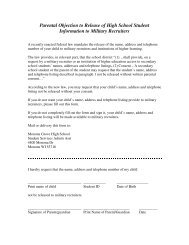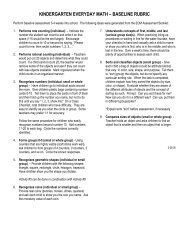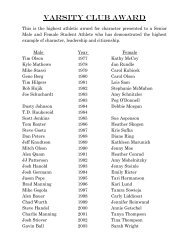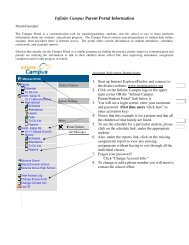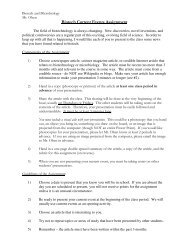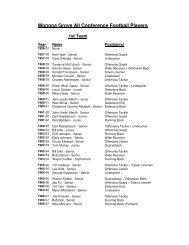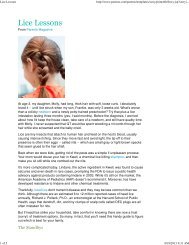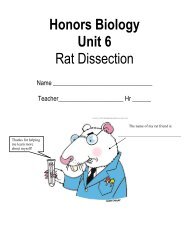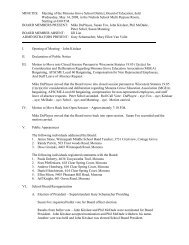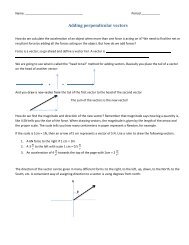Packet for Cu lab, naming and writing formulas, reaction types and ...
Packet for Cu lab, naming and writing formulas, reaction types and ...
Packet for Cu lab, naming and writing formulas, reaction types and ...
Create successful ePaper yourself
Turn your PDF publications into a flip-book with our unique Google optimized e-Paper software.
3) Use a strip of litmus paper to test the pH of the NaOH <strong>and</strong> record it here:___________.<br />
4) Prepare a cold water bath <strong>for</strong> the <strong>reaction</strong> you are about to create. Use a 400mL beaker <strong>and</strong> fill it about halfway with cold<br />
water (you will share this beaker with your <strong>lab</strong> table).<br />
5) Place your 200mL beaker inside of the 400mL beaker so that the smaller one is surrounded by the cold water. Carefully<br />
pour the sodium hydroxide into the copper II nitrate in your 200mL beaker, VERY SLOWLY! Use the stirring rod to mix<br />
as you add the NaOH. Record observations of this <strong>reaction</strong> in the box.<br />
• <strong>Cu</strong>(NO 3) 2:<br />
Observations be<strong>for</strong>e <strong>reaction</strong><br />
Observations during <strong>and</strong> after the <strong>reaction</strong><br />
• During <strong>reaction</strong>:<br />
• NaOH:<br />
• After <strong>reaction</strong>:<br />
6) Keep stirring until all of the NaOH has been added. Use another strip of litmus paper to test the pH of the resulting<br />
solution. If the pH does not match that of the original NaOH, add more NaOH until the colors of the pH papers match.<br />
D. What evidence of chemical change did you observe? ________________________________________________<br />
____________________________________________________________________________________________<br />
E. Was the <strong>reaction</strong> an exothermic or endothermic <strong>reaction</strong>? Describe your answer: ___________________________<br />
____________________________________________________________________________________________<br />
F. The <strong>reaction</strong> you completed is described below. Write it in symbols:<br />
The combination of copper (II) nitrate <strong>and</strong> sodium hydroxide yield copper (II) hydroxide <strong>and</strong> sodium nitrate.<br />
G. Now circle the reactants, <strong>and</strong> put a square around the products. Remember to <strong>lab</strong>el each reactant <strong>and</strong> product as<br />
(s), (l), (g), or (aq).<br />
For the next <strong>reaction</strong> you will work with an open flame. Collect your hair <strong>and</strong> any dangling jewelry <strong>and</strong> never leave<br />
the flame unattended.<br />
7) Add 100mL of distilled water to your 200mL beaker <strong>and</strong> stir.<br />
8) Adjust your ring st<strong>and</strong> so that the ring is about half foot off of the <strong>lab</strong> table. Make sure the ring is secure <strong>and</strong> place your<br />
beaker on it. Place a Bunsen burner underneath the ring st<strong>and</strong> <strong>and</strong> carefully light it. Stir the contents of your beaker as<br />
you are heating it. Remove the beaker when no further color change is occurring. Record your observations.


